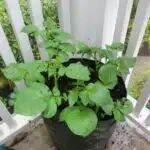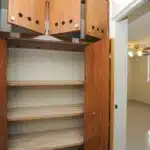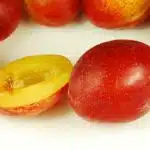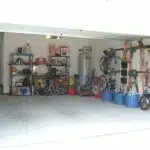As a professional organizer and home storage expert, I have witnessed firsthand how a disorganized home can cause stress and anxiety for many individuals. One area that often gets overlooked in the realm of organization is the storage of grocery bags. Many people tend to accumulate an excessive amount of plastic or paper bags from their grocery runs, which can take up valuable space if not stored properly.
In this article, I will provide step-by-step instructions on how to fold grocery bags for efficient storage. These techniques will not only help you save space but also reduce clutter in your home. By following these simple tips, you can maintain a more organized living space and alleviate unnecessary stress in your daily life.
The Importance Of Proper Grocery Bag Storage
Proper grocery bag storage is a crucial component of maintaining an orderly and clutter-free home. By taking the time to fold and organize your bags, you can ensure that they are readily available when needed and don’t take up unnecessary space. Additionally, proper storage can help extend the life of both reusable and plastic bags.
The benefits of reusable bags are well-documented. They’re environmentally friendly, sturdy, and often more spacious than their plastic counterparts. However, they still require proper storage to maintain their usefulness. Folding them neatly before storing ensures that they don’t become wrinkled or damaged by being shoved into a drawer or closet.
On the other hand, plastic bags have a massive environmental impact. They take hundreds of years to decompose and often end up in landfills or oceans where they harm wildlife and pollute our planet. Proper storage not only prevents these harmful effects but also helps reduce clutter in your home. By designating a specific area for plastic bag storage, you can keep them out of sight while also making sure they’re ready for reuse when necessary.
When it comes to assessing your bag collection, there are several factors to consider beyond simply how many bags you have. Are they all in good condition? Do you have more than you need? Taking stock of your inventory can help you identify which bags should be kept for future use and which ones may need to be recycled or discarded. With this assessment complete, you’ll be ready to move on to the next step: folding your bags for optimal storage.
Assessing Your Bag Collection
Assessing your bag collection can be compared to a treasure hunt where you are searching for precious gems. Taking a minimalist approach is key to organizing your bags. It is important to keep in mind that although you may have an emotional attachment to some of your bags, it is essential to analyze their practicality and usefulness.
To assist with assessing your bag collection further, here are three bullet points that will simplify the process:
- Take all your bags and lay them out in one area, so you can see how many you have.
- Assess each bag’s condition by checking for rips, tears or stains.
- Identify which bags serve a purpose and which ones do not.
Once you have completed the assessment of your bags, it is time to decide what to do with any excess bags. Donating excess bags to charity organizations that could benefit from them is a great way to give back. Not only will this help keep your storage space organized but also provide support for those in need.
Now that you have assessed your bag collection and donated any excesses, the next step is sorting by bag type. It’s important to identify different types of bags such as grocery, tote, backpacks and purses before proceeding with proper organization techniques.
Sorting By Bag Type
Organizing your grocery bags by type is a great way to keep them neat and tidy. By categorizing them into reusable bags, plastic bags, and paper bags, you can easily find the right bag for the job. This also helps in reducing clutter and making space for other items in your storage area.
Bag storage hacks can come in handy when sorting your grocery bags by type. One of the best ways is to use a hanging organizer with separate compartments for each type of bag. This makes it easy to grab the bag you need without having to rummage through a pile of mixed-up bags. You can also use labeled bins or baskets to store your sorted bags on shelves or inside cabinets.
Organizing tips include lengthening the lifespan of your plastic bags by storing them in a cool and dry place away from direct sunlight. You can also fold them neatly before storing to save space and prevent tangling. For reusable bags, consider folding them according to size and shape before storing them together in one designated container. Paper bags are best stored flat, as they tend to take up more space when folded.
Preparing your bags for folding is an essential step before sorting and storing them properly. In the next section, we will discuss easy steps on how to prepare your grocery bags for efficient folding and storage.
Preparing Your Bags For Folding
Choosing materials is an important first step in preparing your bags for folding. Using reusable and durable materials such as canvas, nylon or polyester will ensure that your bags hold up well over time. These materials are also easier to fold as they do not easily crease or wrinkle. In addition, choosing materials made from recycled materials also helps in reducing waste.
Reducing waste is another important consideration when it comes to preparing your bags for folding. Avoid using plastic bags as they are not eco-friendly and contribute significantly to environmental pollution. Instead, opt for reusable grocery bags that can be used multiple times before disposal. By doing so, you will be contributing towards the reduction of waste in our environment.
Once you have chosen the right material and have reduced waste by opting for reusable bags, you can now prepare them for folding. The basic fold involves laying the bag flat and smoothing out any wrinkles or creases. Next, fold the sides of the bag inwards until they meet at the center of the bag. Finally, fold the bottom of the bag up towards the top and tuck it inside one of the side folds. This basic fold ensures that your bags take up less storage space while still being easily accessible when needed.
Transition: Now that you have prepared your bags by choosing durable and eco-friendly materials, reducing waste by opting for reusable bags, and learned how to do the basic fold, let’s explore some additional folding techniques that can help maximize storage space even further.
The Basic Fold
After preparing your bags for folding, it’s time to learn the basic fold. This will help you save space and keep your grocery bags organized. To start, lay the bag flat on a surface. Next, bring one corner of the bag to the opposite corner, forming a triangle.
Once you have made the triangle shape, smooth out any wrinkles and creases in the fabric. Now, take the bottom of the triangle and fold it up towards the top point of the triangle. Repeat this step several times until you have a long strip of fabric left at the top of your triangle. Finally, fold this strip down over all of your previous folds to create a neat package.
To make storing even easier for yourself, try experimenting with alternative folds. The envelope fold is an excellent option if you want to avoid having a long strip at the end of your folded bag. Another popular option is simply rolling up your grocery bags instead of folding them. However, be careful not to make common mistakes like leaving items inside or overstuffing them before folding.
Incorporating these folding methods into your routine can help reduce clutter in your home while making trips to and from stores more convenient. The next section will go into more detail about another popular folding technique: the triangle fold.
The Triangle Fold
The triangle fold is a popular method for folding grocery bags due to its ability to create a compact shape that can fit into tight spaces. To begin this fold, lay the bag flat on a surface and smooth out any wrinkles or creases. Next, grab one of the bottom corners of the bag and bring it up towards the top of the bag, creating a diagonal fold. Repeat this step with the opposite bottom corner.
Once both bottom corners have been folded upwards, take one side of the bag and fold it towards the center, creating a straight edge along one side. Repeat this step with the opposite side of the bag. Finally, fold the entire bag in half by bringing one end up towards the other end. This will create a small triangular shape that can be stored easily in a drawer or container.
While there are benefits to using the triangle fold for storing grocery bags, there are also some drawbacks to consider. One potential issue is that this method requires more folding than other techniques, which may make it less appealing to those who prefer quick and easy storage solutions. Additionally, depending on how tightly you fold each section of the bag, it may not hold its shape as well as other methods.
If you’re looking for an alternative folding method for your grocery bags, consider trying out the envelope fold. This technique involves folding each side of the bag towards the center before folding it in half vertically. The result is a rectangular shape that can be stacked neatly with other folded bags. Experimenting with different folding methods can help you find what works best for your storage needs and preferences without taking too much time or effort.
The Envelope Fold
Like a letter carefully tucked inside an envelope, the envelope fold is a smart way to store your grocery bags. This technique creates a compact and organized bundle that can be easily stored in your pantry or even in your car’s glove compartment. The envelope fold also allows you to reuse your bags without worrying about their tangled mess.
There are variations to the envelope fold, but the basic technique involves folding the bag in half vertically, then folding it in half again horizontally. Afterward, tuck one of the handles into the other handle and flatten the bag into a neat rectangle. Another variation involves folding each corner of the bag towards its center and repeating this process until you have a small square that can be flattened.
Aside from being convenient for storing grocery bags, there are creative uses for folded bags as well. For example, they can be used as padding for delicate items during moving or shipping. They can also be used to stuff toys or pillows for added cushioning. The possibilities are endless with these versatile little bundles.
Transitioning into our next technique, let’s take a closer look at how to achieve another practical way of storing grocery bags: the accordion fold.
The Accordion Fold
The Accordion Fold is a popular technique for folding grocery bags for storage. This method involves folding the bag in half, then folding it in half again, and repeating until the desired size is achieved. The result is a neat and compact bundle that can be stored in a drawer or on a shelf.
Benefits of using the Accordion Fold include saving space and keeping your bags organized. By folding your bags this way, you can fit more bags into a smaller space, making it easier to store them neatly and efficiently. Additionally, because the folds are uniform, it’s easy to see how many bags you have at a glance and grab one quickly when you need it.
Alternatives to the Accordion Fold include the Burrito Roll and the Triangle Fold. While these methods also work well for storing grocery bags, they may not be as space-saving as the Accordion Fold. The Burrito Roll involves rolling up the bag from one end to the other like a burrito, while the Triangle Fold involves folding the bag into a triangle shape before rolling it up.
Next up is the Burrito Roll, another popular method for storing grocery bags. This technique involves rolling up the bag tightly from one end to the other, creating a compact roll that can be secured with an elastic band or stored in a container. With this method, you can easily store your grocery bags in small spaces like drawers or baskets without taking up too much room.
The Burrito Roll
The Burrito Roll is a popular method for folding grocery bags that has been gaining popularity among home storage enthusiasts. This technique involves folding the bag in half vertically, tucking in the handles, and then rolling the bag tightly from one end to the other. The result is a compact bundle that can be stored easily in a drawer or on a shelf.
One of the benefits of using the Burrito Roll method is that it takes up very little space. Because the bags are rolled tightly, they can be stacked neatly without taking up much room. Additionally, this method helps to prevent wrinkles and creases in the bags, which can make them difficult to use later on.
While there are alternative methods for folding grocery bags, such as the Triangle Fold or the Square Fold, these techniques are not as efficient as the Burrito Roll. The Triangle Fold requires more steps and leaves more loose ends, while the Square Fold creates bulky bundles that take up more space than necessary. Overall, if you’re looking for an easy and effective way to store your grocery bags, the Burrito Roll is definitely worth considering.
Transition: Now that you know all about the benefits of using the Burrito Roll method for folding your grocery bags, let’s move on to another popular technique: The Fan Fold.
The Fan Fold
Transitioning from the burrito roll, another efficient method of folding grocery bags for storage is the fan fold. This technique involves folding the bag in a zig-zag pattern until it forms a compact rectangle. Unlike the burrito roll, the fan fold allows for easy dispensing of bags as they can be pulled out individually from the top of the stack.
One of the benefits of using the fan fold is that it maximizes space when storing bags. As bags are folded into a compact shape, they can be easily stored in a drawer or container without taking up too much space. Additionally, this method ensures that bags remain wrinkle-free, which prevents them from tearing or wearing out quickly.
Alternative methods to folding grocery bags include techniques such as stuffing them into a larger bag or balling them up. However, these methods make it difficult to retrieve individual bags and can lead to cluttered storage spaces. Overall, using the fan fold when storing grocery bags is an efficient and space-saving solution that ensures easy dispensing and prolongs their lifespan.
Transition: Moving on from the fan fold, another popular technique for folding grocery bags is known as “the origami fold.”
The Origami Fold
Using the Origami Fold Technique is an excellent way to fold grocery bags for storage. This folding method ensures that the bag takes up minimal space, and it is easy to retrieve when needed. To begin, lay the bag flat on a smooth surface with the handles facing upwards. Then, flatten the bag by smoothing out any wrinkles or creases.
Next, fold the bottom of the bag up to meet the top edge, creating a rectangle shape. Then, take one side of the rectangle and fold it inwards towards the center of the rectangle. Repeat this process with the other side, ensuring that both sides meet in the middle. You should now have a small rectangular shape that you can easily store in a drawer or bin.
Storing grocery bags vertically using this technique can help maximize storage space while keeping your bags organized. Once you have folded your bags using this method, stand them upright in a container such as a plastic bin or even a cardboard box. This will allow you to access each bag easily without having to dig through a pile of unfolded bags. In our next section, we will introduce another folding technique called ‘the knot fold.’
The Knot Fold
Transition: Now that we’ve covered the origami fold, let’s explore another folding technique for grocery bags. The knot fold is a popular choice for those who prefer a simpler approach to organizing their bags.
Different types of knot folds exist, but the most common method involves simply tying a knot in the middle of the bag. This creates two loops on either end, making it easy to hang and store in a pantry or closet. Another variation involves folding the bag into thirds before tying the knot, which results in a more compact storage option.
One advantage of the knot fold is its simplicity and speed. It takes less time to tie a knot than to carefully fold each bag into an intricate shape. Additionally, because the bags are not tightly compressed like with some other folding techniques, they can maintain their shape and be reused more easily. However, some may find that knots take up more space than folded bags when hung on hooks or stored in baskets.
In conclusion, while there are different types of folds for grocery bags, the knot fold provides a simple and efficient solution for storage. Its pros include ease and speed of use as well as maintaining the shape of the bag for future use. However, its cons may include taking up more space when hung or stored compared to other folding techniques. In our next section, we will discuss tips for storing your folded bags to maximize space efficiency in your home.
Storing Folded Bags
- There are a variety of folding techniques for storing grocery bags, such as rolling, folding flat and forming a pouch.
- Folding grocery bags for storage helps minimize mess, keeps them contained and allows for easier access when needed.
- Reusing identical folds over time can help increase efficiency and organization, while also helping to create a consistent look.
- There are several benefits of folding grocery bags, including conserving storage space and displaying them in an aesthetically pleasing way.
- When folding grocery bags, it is important to consider the type of fold that works best for the storage space and the number of bags that need to be stored.
- With a few simple steps, grocery bags can be folded and stored with ease, creating an orderly and clutter-free space.
Folding Techniques
When it comes to storing folded grocery bags, mastering the right folding technique is crucial for maximizing space and minimizing clutter. Many people make the common mistake of simply stuffing the bags into a drawer or cabinet, resulting in a jumbled mess that takes up unnecessary space. However, with a few creative alternatives and a basic understanding of folding techniques, you can easily store your bags in an organized and efficient manner.
One popular folding technique is the triangle fold. To achieve this, start by laying the bag flat on a surface and smoothing out any wrinkles or creases. Next, fold the bag in half vertically so that the handles are aligned. Then, fold one bottom corner up to meet the top edge of the bag, creating a triangle shape. Repeat this step with the other bottom corner to create a smaller triangle shape at the bottom of the bag. Fold this triangle up towards the top of the bag and tuck it neatly inside. This method creates a compact triangular shape that is easy to stack and store.
Another useful folding technique is known as the roll-up method. This involves rolling up each bag tightly from bottom to top and then securing it with an elastic band or ribbon. Not only does this method save space by allowing you to stack multiple rolls on top of each other, but it also makes it easy to grab just one bag at a time without disrupting your entire storage system.
In conclusion, learning how to fold grocery bags properly can make all the difference when it comes to keeping your home tidy and organized. By avoiding common mistakes such as haphazardly stuffing bags into drawers or cabinets, and instead utilizing creative alternatives like triangle folds or roll-up methods, you can keep your grocery bags neatly stored while saving valuable space in your home.
Benefits Of Folding
Folding bags is essential for efficient storage, and it offers several benefits. One of the most significant benefits is space-saving. When folded correctly, bags take up little room in drawers or cabinets, leaving more space for other items. Additionally, folded bags are easier to organize and access. Unlike stuffed bags that can quickly become cluttered and disorganized, properly folded bags remain neat and easy to find.
Another benefit of folding bags is that it promotes sustainability. Reusing grocery bags helps reduce waste and the environmental impact caused by single-use plastic bags. By folding reusable grocery bags neatly after use, you can extend their lifespan even further, reducing your carbon footprint.
Various techniques can be used when folding grocery bags, such as the roll-up method or triangle fold technique mentioned earlier. These methods not only save space but also prevent wrinkles and creases from forming on the bag’s surface. Properly folded grocery bags maintain their shape, ensuring they stay in good condition for longer periods.
In summary, mastering the art of folding grocery bags can have numerous benefits beyond just creating an organized home storage system. By utilizing techniques that save space and promote sustainability while maintaining the bag’s condition, you can maximize your bag’s usefulness while minimizing clutter in your home.
Reusing Folds
Now that we have discussed the benefits of folding grocery bags, let us turn our attention to storing them. Storing folded bags is crucial because it ensures that they remain in good condition and are readily accessible when needed. One way to store folded bags creatively is by repurposing items that you already have at home, such as a tissue box or an old shoebox. These creative alternatives not only save space but also add a touch of personalization to your storage system.
Reusing folds is another excellent way to maximize your bag’s usefulness while reducing waste. When you unfold a bag, it may not always return to its original shape or size, making it challenging to reuse effectively. However, by reusing folds, you can ensure that the bag retains its original form while also saving storage space. For example, if you fold a bag using the triangle fold technique, you can easily refold it in the same manner for future use.
In conclusion, storing folded bags requires creativity and strategic planning. By repurposing items and reusing folds, you can reduce waste while maximizing your storage space. Remember that proper storage techniques and habits will not only keep your home organized but also promote sustainability and reduce your carbon footprint.
Utilizing Storage Containers
What are your options for storing your perfectly folded grocery bags? Using storage containers is an ideal solution. Not only do they keep your bags contained and organized, but they also maximize small spaces in your home. Here are some storage container options to consider:
- A plastic bin with a lid: This option is great for keeping bags contained and out of sight. You can easily stack multiple bins on top of each other to save space.
- An over-the-door organizer: This handy organizer hangs on the back of a door, making it perfect for small spaces. You can use the pockets to store folded bags or even other items like cleaning supplies.
- A hanging basket: Instead of using a traditional basket that takes up valuable floor space, consider a hanging basket that you can hang from the ceiling or a hook on the wall. This option allows you to store bags vertically, maximizing space.
- A fabric storage cube: These cubes come in different sizes and colors, making them an attractive solution for storing grocery bags. They can also be easily stored on shelves or under beds.
By utilizing these storage container options, you can free up valuable counter or closet space while keeping your grocery bags organized and easily accessible. Remember to choose containers that fit your needs and style preferences.
To maintain continued organization, regularly go through your bag collection and discard any damaged or unneeded bags. Also, make sure to return all used bags to their designated container immediately after use. By sticking to these simple habits, you’ll ensure continued success in maintaining an organized home.
Maintenance And Continued Organization
Maintaining an organized and clutter-free home requires ongoing effort and dedication. Once you have sorted, decluttered, and found a space for each item in your home, it is important to establish a system to keep everything in order. One way to achieve this is by labeling your grocery bags. When you label each bag with its contents, you will save time when searching for specific items later on. You can use simple labels or even color-coded ones for added organization.
Creative storage solutions can also help keep your home tidy and organized. Consider using over-the-door organizers for shoes, jewelry, or cleaning supplies. You can also use under-bed storage containers for seasonal clothing or linens. Another option is to repurpose household items as storage solutions, such as using a bookshelf for pantry organization or mason jars to store small items like buttons or craft supplies.
Incorporating these maintenance and continued organization strategies into your daily routine will result in a more functional and efficient home. By labeling bags and finding creative storage solutions for your belongings, you will be able to easily locate items when needed and maintain a clutter-free environment. Remember that staying organized requires consistent effort, so make sure to set aside time regularly to re-evaluate and adjust your systems as needed.
Conclusion
Proper storage of grocery bags may seem like a trivial matter to some, but it can actually make a big difference in maintaining an organized and clutter-free home. By following these simple steps, you can keep your grocery bags neat and tidy, ready for use whenever you need them.
Firstly, assess your bag collection and sort by type. This will make it easier when it comes time to fold and store them. Next, prepare your bags for folding by ensuring they are clean and dry. Then, choose between the basic fold or knot fold techniques, depending on your personal preference.
Storing folded bags can be done in various ways, such as using storage containers or hanging them on hooks. Whatever method you choose, be sure to maintain the organization by regularly checking and refolding any loose bags.
In conclusion, proper grocery bag storage may not be rocket science but it is certainly worth investing some time into. By following these simple steps and keeping an organized approach to bag storage, you can save yourself from the frustration of tangled messes and unnecessary clutter in your home. Remember – tidiness is next to godliness!
Image Credits
- “Plastic grocery bags become a purse!” by Kerri9494 (featured)





























